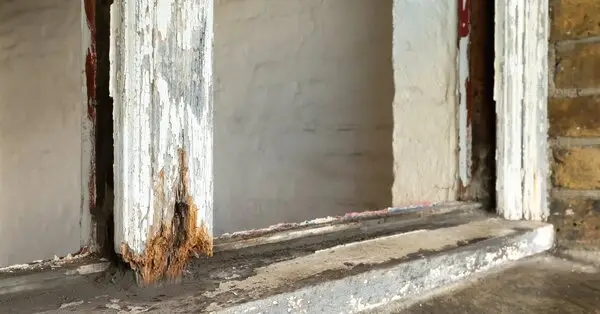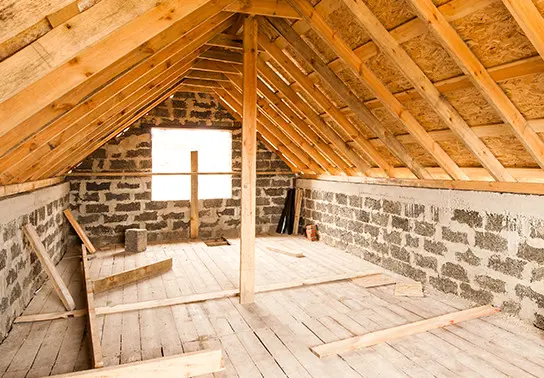When you hire our expert Dallas wood rot repair technicians, expect their meticulous attention to detail to bring you the results you need. First, they’ll provide you with a detailed diagnosis by detecting the type of fungal growth you’re dealing with.
Once we have a diagnosis, there is a preparatory step, which involves removing all the rotted parts before they can spread further. Also, if the material is soaking wet, it must dry first because we can determine how patching and replacing are needed.
Depending on the level of damage, it is often more cost-effective to replace the wood rather than using epoxy resin. The reason is that there is a two-phase process with epoxy repairs, starting with liquid epoxy, followed by moldable, sculpted putty (or kneadable epoxy) to fill the missing wood areas. Afterward, it needs time to dry before it’s sanded down and stained. Alternatively, we also offer painting services.
Common types of wood rot that Mr. Handyman handles include:
DRY ROT:
This is the brown variant—a member of the brown-rot fungi. It is known to be the most destructive and fastest-growing type. It consumes and breaks down the timber’s cellulose from the core, so the whole structure appears to be shrinking. The most dangerous area to have dry rot is in your attic, where attic joists provide structural integrity to your house. Outdoor areas include your crawl space, decking, and fencing system.
Though it may be difficult to determine if you need wood rot repair, Dallas, TX homeowners are recommended to keep an eye out for these common warning signs:
- Surface cracks or holes
- Velvety texture
- Discoloration faded colors
- Shrinking timber
- Musty smells
- Brittle and crumbling
- Cubical fracture
WET ROT:
Other types of wood-eating fungi include wet or soft rot, which, unlike the brown variant, grows slightly slower. Rather than aggressively attacking the timber’s lignin or cellulose, it gradually weakens it. In this case, using boric acid (as a type of fungicide) often works wonders.
Telltale signs of soft rot include:
- Dark brown stains
- Discolored, damp surface
- Damp smells
- Softened texture
Why Choose Mr. Handyman For Dallas Wood Rot Repair?
Your highly trained and experienced handyman team at Mr. Handyman of Dallas brings an average of ten years of experience, providing excellent workmanship with guaranteed customer satisfaction. As an acknowledged member of Neighorly’s top home service franchise, we are proud to be your locally owned and operated handyman business in Dallas. Our local customers have referred to us as their one-stop shop for all their handyman needs. From tile repair to fence installation and custom carpentry service, our Dallas handyman service professionals have you covered.
Dallas Wood Rot Repair FAQs
WHAT IS THE BEST WAY TO STOP ROTTED WOOD FROM SPREADING?
The sooner you detect it, the better the fungicide will be able to stop the spread. There are also rotted wood restorers or dry rot treatment fluids that you can use. But often, the most effective solution is to replace the affected piece of wood with a pre-treated one.
HOW DO YOU FILL LARGE HOLES IN ROTTED TIMBER?
Depending on the number of holes and the overall extent of the damage, you may be able to fix it with epoxy fillers. Often, combining epoxy with sawdust creates a strong paste that can be used during your Dallas wood rot repair by simply filling the affected areas.
CAN YOU APPLY EPOXY DIRECTLY TO ROTTED LUMBER?
It may sound easy but it isn’t. In many cases, your Dallas wood rot repair process requires a drying time. Also, the rot must be removed first before you apply any consolidants, followed by a filler. We understand that it can be difficult to determine the type of rotten wood you have, which makes the repair process tricky. When you hire your Dallas wood rot repair technicians from Mr. Handyman, we’ll guarantee to get the job done right without any headache.
WHICH ARE THE MOST COMMON PLACES THAT NEED WOOD ROT REPAIR?
Dallas, TX property owners will be surprised to find out how many wooden structures they have on their property for building materials. The most common places to inspect periodically include:
- Attic: joists, beams
- Crawl space
- Trims: fascia boards, corner boards
- Sheathing beneath the house siding
- Decking boards
- Fence
- Roof
- Window sills, window frames
- Door frames
- Baseboards
 Click to call
Click to call




